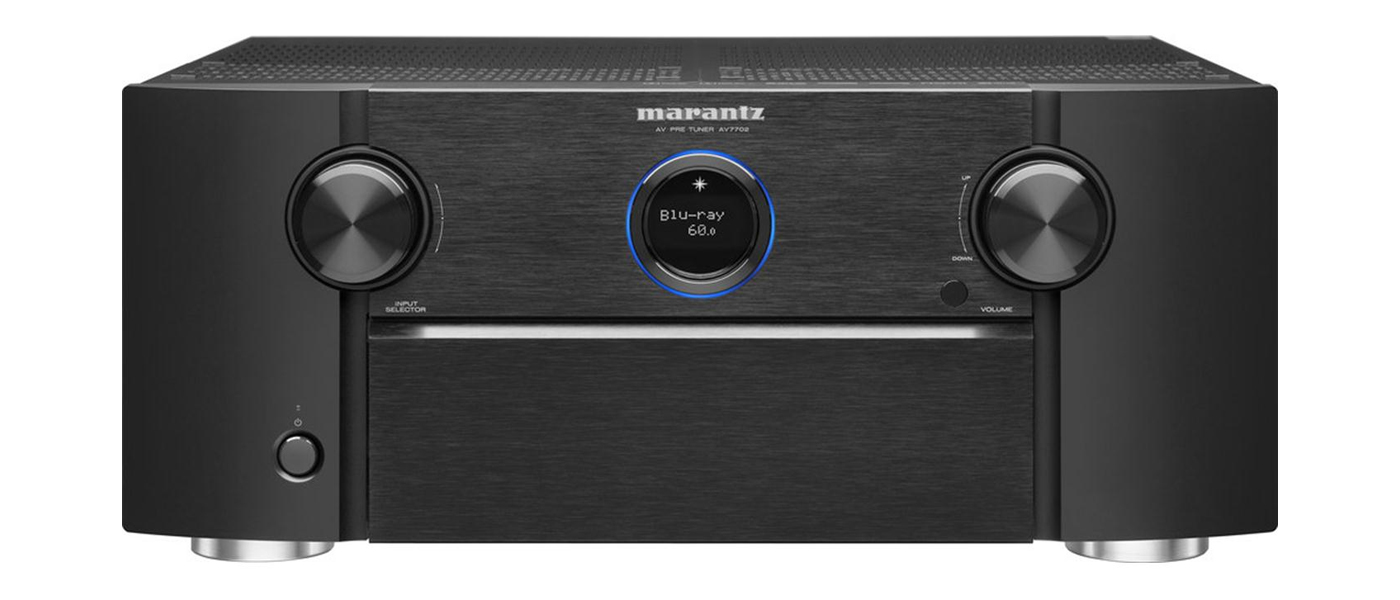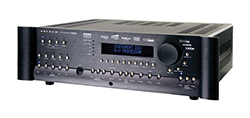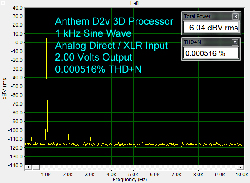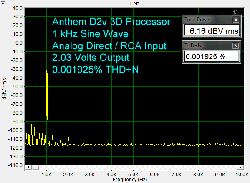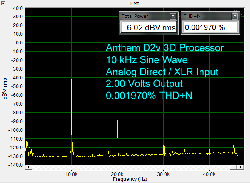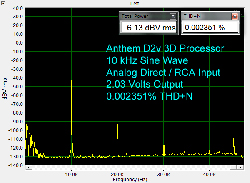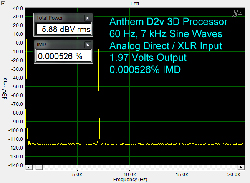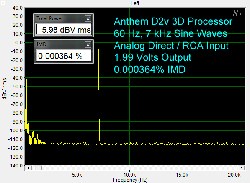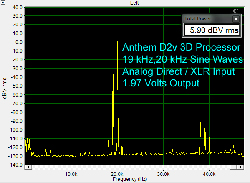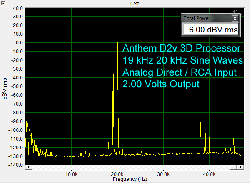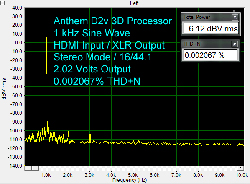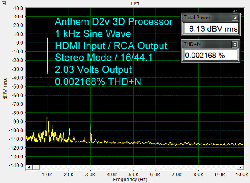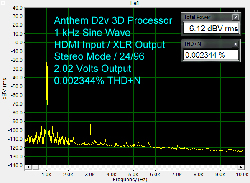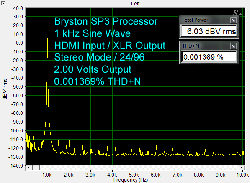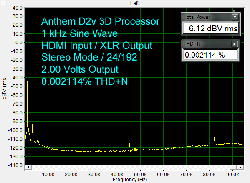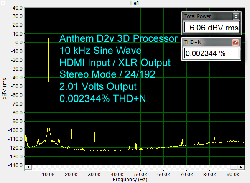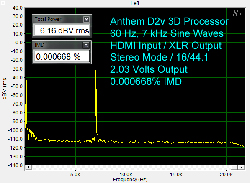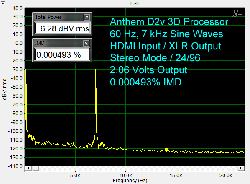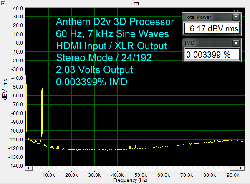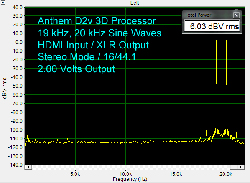Anthem Statement D2v 3D Processor Review Highlights
Anthem’s Statement Collection has always been focused on the best possible audio and video performance. In this review, we take a look at the Anthem Statement D2v 3D processor, which is the latest update for this well-regarded 7.1 channel processor. The Statement D2v 3D is an incremental upgrade over the previous Statement D2v processor and adds support for HDMI v1.4a and video passthrough for 3D content. Secrets has published a series of articles on build quality and how component choices contribute to high-performance design. The Statement D2v 3D is a great example of a product that was designed with high performance in mind. The Statement D2v 3D doesn’t have all the latest features, but it delivers excellent audio and video performance for both two-channel stereo and multi-channel music and movies alike.
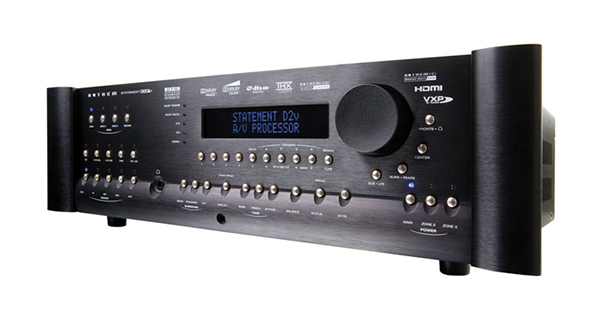
Anthem Statement D2v 3D Processor Highlights Summary
- The Statement D2v 3D includes Anthem Room Correction using the ARC-1 RS-232 serial-interface.
- The Statement D2v 3D performed very well on the bench with very low distortion measurements.
- The Statement D2v 3D includes a Sigma VXP video processor, supports HDMI v1.4a, and offers a video passthrough mode for use with 3D and 2D video.
- The sound is reference quality with excellent detail and a wonderfully silent noise floor.
- This is most likely the last upgrade we’ll see on this generation of the Statement D2v hardware.
Introduction to the Anthem Statement D2v 3D Processor Review
The Anthem Statement D2v 3D processor is the latest incremental upgrade to Anthem’s top-of-the-line audio/video processor. The need for this latest upgrade comes once again due to the evolution of the HDMI specification. While the previous Statement D2v processor supported HDMI v1.3c and was more than capable of handling the high resolution audio formats found on today’s Blu-ray discs, it was not able to handle 3D video content. While the overall demand for 3D content has been low, Anthem developed the Statement D2v 3D and added support for four HDMI v1.4a inputs and one HDMI v1.4a output. Anthem included a video passthrough mode which allows the Statement D2v 3D to properly send 3D video content via HDMI to a 3D-capable television. We have reviewed lots of Anthem processors at Secrets over the years, and it was time we did an update on the Statement D2v 3D. I used an Anthem Statement D2 processor in my home theater for years, so I was excited to take a closer look at the Statement D2v 3D flagship processor and see how it performs on the bench.
ANTHEM STATEMENT D2V 3D PROCESSOR REVIEW SPECIFICATIONS
- Design: 7.1 Surround Sound Processor (SSP, Pre-Pro)
- Codecs: Dolby Digital, Dolby Digital EX, Dolby Digital Plus, Dolby TrueHD, DTS, DTS-ES (Discrete, Matrix), DTS 96/24, DTS-HD Master Audio, DTS-HD High-Resolution Audio
- Dynamic Range Control: Dolby Volume
- DACs: AKM AK4395 24-Bit/192kHz Delta-Sigma
- DSP: Two Dual-Core processors
- 3-Zone Operation
- Video Connections: HDMI 1.4a (4 in, 1 out) , HDMI 1.3c (4 in, 1 out), Component ( 4 in, 2 out), S-Video (7 in, 1 out), Composite (7 in, 1 out)
- Audio Connections: HDMI (8 in), Stereo Inputs (7 RCA in, 1 XLR in), Optical (3 in, 1 out), Coaxial Digital (7 in), AES/EBU (1 XLR), 5.1 Multi-channel (1 in), Pre-amp out (7.1 RCA and XLR)
- Other Connections: 12V Triggers (3 out), RS-232, IR (3 in, 2 out), 2nd Zone (Stereo Audio, S-Video, Component, Composite), 3rd Zone (Stereo Audio, Composite), Headphone Jack (1/4”)
- Dimensions: 6.25″ H x 17″ W x 15.38″ D
- Weight: 27 Pounds
- MSRP: $9,500 USD
- Anthem
- SECRETS Tags: Anthem, Anthem Statement D2v 3D, Surround Sound Processors, Preamplifiers, SSPs
Design of the Anthem Statement D2v 3D Processor
The look and feel of the Statement D2v 3D is identical to its predecessor, the Statement D2v processor. The front and top cover are made from fine-grain brushed aluminum, and there are lots of tiny buttons offering control of source selection, tuner presets, output path selection, listening modes, tone control, and setup. In fact, the only way to tell that processor is the Statement D2v 3D is to check the front display during power-up or by pressing the status button.
The rear panel of the Statement D2v 3D is packed with connection options and is also identical to the rear panel of its predecessor. Inputs have a black background and outputs have a white background. The Statement D2v 3D has eight HDMI inputs and two HDMI outputs. HDMI inputs 1-4 and the first HDMI output support HDMI v1.4a. HDMI inputs 5-8 and the second HDMI output support HDMI v1.3c. While support for analog video is quickly disappearing from the home theater market, the Statement D2v 3D includes four Component video, seven S-Video, and seven Composite video inputs. On the audio side of things, the Statement D2v 3D includes eight stereo inputs, including one balanced XLR input, three optical and seven coaxial digital inputs, and one balanced AES/EBU input. The Statement D2v 3D shows its age by only including a 5.1 multi-channel input despite being able to process up to 7.1 channels of 24-bit/192 kHz PCM audio over HDMI.
The Statement D2v 3D supports all the high-resolution audio codecs like Dolby TrueHD and DTS-HD Master Audio, is THX Ultra2 certified, and supports Dolby Volume. The Statement D2v 3D includes Anthem’s highly regarded Anthem Room Correction (ARC) system, but it still uses the older ARC-1 RS-232 serial-interface. The Statement D2v 3D includes a professional quality Sigma VXP video processor that provides fully adaptive deinterlacing, extensive video control for things like color space, 3D noise reduction, detail and contrast enhancement, and support for Deep Color. A video passthrough mode allows the Statement D2v 3D to properly send 3D video content via HDMI to a 3D-capable television. The passthrough mode can also be used with 2D content to bypass the internal video processor.
The Statement D2v 3D includes three IR inputs, two IR outputs, and an RS-232 jack for use with external control systems. Three 12-Volt DC Triggers are also included, which allow you to turn on another device, such as an external amplifier for multi-zone operations.
The Statement D2v 3D comes with a basic back-lit remote.
To understand the design of this processor, it’s helpful to take a quick look back at the history of the Statement product line. The original version of the Anthem Statement processor came out in early 2004 and it was called the Statement D1. The D1 built upon Anthem’s legacy with the AVM-20 processor and added premium component construction including AKM AK5394A ADCs, AKM AK4395 DACs, Burr-Brown OPA-2132 op-amps, Wima film capacitors, and Cirrus Logic (Crystal) CS3310 volume controls, while the 6-channel analog input used differential circuitry. Perhaps the biggest feature of the D1 was its prowess in handling digital audio thanks to a fulltime 24-bit/192kHz upsampler and 128X oversampling to increase the sample rate to 24.576 MHz, which ensured the best possible phase- and frequency-response. The upsampler operated on all incoming digital audio signals regardless of format. In 2006, the Statement D2 was released and it built upon the D1 by adding a Gennum VXP video-processor, four HDMI v1.1 inputs, and support for 1080p24 and 1080p60 video input and output. With those capabilities, the Statement D2 was ready for the introduction of Blu-ray in late 2006. I remember reading Kris Deering’s review of the Statement D2 for Secrets with much anticipation. After reading that review, I became an early adopter of the Statement D2 and used the Statement D2 as my reference processor in my own home theater for over eight years.
With support for HDMI came all the challenges of handling HDMI connectivity issues. Anthem did a fantastic job supporting their customer base with frequent firmware updates addressing numerous issues and often working around problems caused by other manufacturers’ components. Anthem introduced their highly-regarded Anthem Room Correction (ARC-1) system and offered ARC as an upgrade for existing Statement D2 and D1 customers. I remember buying the ARC upgrade for my D2 and thinking how happy I was to have this new functionality without having to upgrade to an entirely new processor.
The advent of high-resolution audio formats like Dolby TrueHD and DTS-HD Master Audio precipitated the introduction of the Anthem Statement D2v processor in 2009. The D2v supported 8 HDMI v1.3c inputs, parallel HDMI v1.3c outputs, up to 7.1 channels of PCM at 24-bit/192 kHz, the latest Sigma VXP video processor, Deep Color, and would support Dolby Volume via a later firmware upgrade. While Anthem supported an “upgrade” path to the new D2v, that process essentially involved returning an existing D2 processor to an Anthem dealer and Anthem would ship out a completely new D2v to replace it.
This brings us to the Statement D2v 3D which is the latest, and most likely the final, iteration of this venerable processor. The audio side of this processor has remained unchanged since the original release of the Statement D1 back in 2004. The processor’s computing power was substantially upgraded when Anthem introduced two dual-core DSP processors in the D2v, and this additional processing capability was well spent on Dolby Volume and on decoding high-resolution audio formats like Dolby TrueHD and DTS-HD Master Audio. The underlying AKM AK5394A ADCs and AKM AK4395 24-Bit/192kHz Delta-Sigma DACs remained unchanged, as did Anthem’s use of the Analogue Devices AD1896 ASRC (Asynchronous Sample Rate Converter). The full-time upsampler is a hallmark of the Statement D-series design and a testament to the benefits of quality design and engineering.
While the audio side of the Statement D2v 3D has remained unchanged, the heavy lifting has taken place with the video board, the HDMI interface, and the numerous software changes that were made to support HDMI v1.4a. Keep in mind that upgrading the HDMI side of the processor also meant that Anthem had to deal with the expensive process of HDMI certification and testing. If you happen to have an original D2v, Anthem can upgrade your unit to a Statement D2v 3D by replacing the entire video board. If you have a newer D2v with a serial number after 142626, then the Statement D2v 3D upgrade can be done by replacing two smaller video mezzanine-boards with a larger mezzanine board which replaces the first four HDMI inputs and the first HDMI output. This hardware upgrade, together with the new version 3.10 software update, makes the Statement D2v 3D a reality.
Setup of the Anthem Statement D2v 3D Processor
The setup and configuration options on the Statement D2v 3D are extensive. The menu system remains a simple character-based interface that seems almost nostalgic in this day of rich graphical user interfaces. The Statement D2v 3D setup menu has fourteen comprehensive submenus which cover everything from video output, speaker configuration, source setup, and mode presets based on input format, to details like volume presets, trigger assignments, and input levels for analog sources. Fortunately, Anthem includes a very well-written manual that covers the features and operation of the processor. The manual merits reading from cover to cover, if for no other reason than to become familiar with all of the capabilities that this processor has to offer. As the Statement D2v 3D is an upgrade to the prior Statement D2v processor, I am not going to go into extensive detail on the setup of the overall processor but instead focus on the highlights.
In order to take advantage of the 3D and video passthrough functionality, I connected my Oppo BDP-105 to one of the first four HDMI inputs and my 3D-capable television to the first HDMI output. I connected my amplifier and the rest of my source devices and I was in business. I ran through the Anthem Room Correction process, which is identical to the process I described in my review of the MRX-700. ARC setup on the Statement D2v 3D is straightforward but still requires the use of a serial cable and a serial-to-USB adapter if your computer doesn’t have a serial input. Anthem ships a serial-to-USB adapter with the Statement D2v 3D just in case. After setting up ARC on an MRX 710, the old serial interface and ARC-1 software seem so outdated on the Statement D2v 3D. I would have loved to see Anthem upgrade the ARC hardware on the Statement D2v 3D to the network-based interface of the current MRX x10 series. Regardless of the interface, ARC is still one of the best room correction systems on the market and a major feature of the Statement D2v 3D. The ARC filters used on the Statement D2v 3D also have more precision than those on the MRX x10 A/V receivers thanks to the extra DSP processing power available on the Statement D2v 3D.
To enable support for 3D video content, Anthem has introduced a “Through” mode video-processing option that can be assigned to the video-output configuration of any source. In “Through” mode, the internal video processor is bypassed and the output resolution and frame rate are the same as the sources. This approach comes in very handy since one of the major strengths of the Statement D2v 3D is the ability to assign a single HDMI input to multiple sources on the processor. In the case of my Oppo BDP-105 player, I configured three sources for the single player. For example, the DVD1 source was configured for passthrough which enables 3D output and allows 2D sources to bypass the internal video processing. I configured the DVD2 source to use a standard video output configuration of 1080p. I also configured the 2-CH source to use the same HDMI video input along with the balanced XLR stereo inputs from the Oppo BDP-105. This allowed me to see the graphical interface from the Oppo BDP-105 while enjoying the analog performance of the Oppo and the Statement D2v 3D. As you can see, the configuration options can be adjusted for a wide variety of situations, which is also great for custom installers. This flexibility also allows the enthusiast maximum flexibility for comparisons and configuration tweaks as desired.
The other advantage of having 3D support in the Statement D2v 3D is that it simplifies the HDMI cabling in the system. With the older Statement D2v and D2 processors, two HDMI cables were required from the Oppo Blu-ray player: one to the processor for HDMI audio and another to the television for 3D video. With the Statement D2v 3D, only one cable is required from the player for all audio and video content.
The Anthem Statement D2v 3D Processor In Use
For my tests, I was using a McIntosh MC8207 amplifier and a 5.1 speaker configuration from Revel, including a pair of F206 floorstanding speakers, a B110 powered subwoofer, a C205 speaker for the center channel, and a pair of M105 bookshelf speakers for the surrounds. I also used the Statement D2v 3D processor in a seven-speaker configuration from Definitive Technology, using a pair of BP-3000TL speakers with powered subwoofers for the front mains, a CLR 2002 speaker for the center channel, and four Definitive Technology UIW 94/A speakers for the surrounds and rear channels. Cables and interconnects were from Cardas, Monster and Emotiva. The Oppo BDP-105 was my primary source device.
Playing 3D Blu-ray content through the Statement D2v 3D worked exactly as expected. I selected the DVD1 source input, put a movie in the Oppo BDP-105, and put on my 3D glasses. I tested 3D playback with a few titles like Gravity, Prometheus, and Star Trek Into Darkness and the video looked great. The obvious drawback from an operational perspective is that, while in passthrough mode, there is no access to the onscreen displays from the Statement D2v 3D since the internal video processor is bypassed. Not having the volume displayed took some getting used to, but since the front panel is very readable from across a room, it really wasn’t an issue. I was also able to quickly switch to the DVD2 source input and not only see the onscreen displays, but watch the 3D movie in 2D mode. I appreciated the flexibility to easily switch between 1080p 3D and 1080p video with the press of a button and I was pleased with how quickly the Statement D2v 3D responded.
If you are wondering about how the Statement D2v 3D works with a 4K television, I had a chance to test that configuration for a few days with a Samsung UN65HU8550 Ultra HD television. I connected the Statement D2v 3D to the HU8550 and had no problems with either processed video or video passthrough. The Statement D2v 3D handled all the video from the source devices and the HU8550 upconverted the output from the Statement D2v 3D to 2160p resolution. If you happen to have a source device that outputs 4K resolution, then two HDMI cables must be used: one for audio connected to the Statement D2v 3D and another for video connected directly to the UHD television.
From an operational perspective, I was very pleased with how well the Statement D2v 3D handled all of my HDMI sources. I had no handshake issues or audio dropouts with my satellite receiver and even devices like my first-generation Apple TV worked well over HDMI. This was a noticeable improvement over my old Statement D2 which could be temperamental with newer HDMI devices.

From an audio perspective, I am not sure how much more I can add to all the wonderful comments the Statement D2 and D2v processors have received over the years. I loved listening to vocal performances as voices sounded so natural with an amazing sense of presence. For example, listening to Sara Bareilles sing “Beautiful Girl” from her Blessed Unrest album was simply delightful. The sound floor was absolutely dead quiet with only Sara’s beautiful voice and her guitar front and center in my listening room. The detail in her voice was captivating and the guitar sounded so real. The ability to let the sound of voices and instruments emanate from total silence is one of the best qualities of the Statement D2v 3D processor.
I had a similar experience with the 24-bit/96 kHz HDtracks version of Come Away with Me by Norah Jones. I’ve listened to this album many times over the years and the Statement D2v 3D allowed the Revels to deliver Norah’s voice with a wonderfully smooth sound. On track ten, “Painter Song”, I loved the details in her voice. The guitar, drums, bass and accordion that accompany her on this track sounded so natural and they were beautifully placed in the soundstage. I could make out fine details without once being distracted from the beauty of the music. Each instrument acted like a unique voice accompanying Norah’s vocals. The sound of the accordion was especially rich and conveyed beautiful emotion, reminding me of trips to Paris. This is definitely how music should be enjoyed.

For a concert experience, I listened to the “Dave Matthews and Tim Reynolds: Live at Radio City” Blu-ray. The Statement D2v 3D easily transported me to the concert hall in New York City. The soundstage was huge and amazingly seamless. Vocals were fantastic and I felt like I was at the performance. I was blown away by the detail in Tim Reynolds guitar playing, especially on the track “Betrayal.” I could feel the sound resonating from his guitar. This is the type of realism that the Statement D2v 3D can recreate.

As for movies, the Statement D2v 3D can deliver an amazingly immersive experience. I watched lots of blockbusters like Gravity, Captain America: The Winter Soldier, and Godzilla and was always impressed with the level of detail and clarity. The Statement D2v 3D can create a huge soundstage and handle all the mayhem of explosions, chase scenes, aliens, monsters, and superheroes with ease. Bass response was always superb thanks to Anthem Room Correction, and dialog and center channel vocals were articulate and well defined.
The Statement D2v 3D is one of those products that just delivers gorgeous sound and listening to this processor with the Revel speaker system was a fantastic experience. It really doesn’t get a whole lot better than this.
From an operational perspective, using the Statement D2v 3D is pretty straightforward. Just select the appropriate input, adjust the volume and enjoy. Surround modes can be tailored based on the original input format, which is a feature I’ve always loved about this processor. Video processing can be tailored as needed based on the capabilities of the source device. I was happy to have the Statement D2v 3D handle the video processing for my satellite box. It was also fun to use the video processor to perform custom cropping and scaling on letterbox content.
The Statement D2v 3D has no network interface, so it does not come with any Android or iOS control apps. The remote control that ships in the box is pretty basic. I wasn’t impressed with the backlight and the buttons are really hard to read in a darkened room. The Statement D2v 3D does have an extensive serial command set which allows the processor to be controlled from an external control system. It can even be controlled over a network using an Ethernet to RS-232 adapter that is supported by many control systems currently on the market.
The Anthem Statement D2v 3D Processor On The Bench
My standard benchmark tests were done using two-channel bypass mode so that all digital signal processing was off. On tests using the XLR input, I measured the XLR preamp output of the D2v 3D. On tests using an RCA input, I measured the RCA preamp output of the D2v 3D. The source device for both analog and HDMI tests was an Oppo BDP-105.
At 1 kHz into the XLR input, THD+N was an impressive 0.000516%. We see only two harmonics in the spectrum with the peak at 2 kHz being about 104 dB below 0 dBFS.
At 1 kHz into the RCA input, THD+N was 0.001925%. We see some hum spurs in the low end of the spectrum which are caused by ground noise from the analog RCA connection. The hum spurs are not present in the previous XLR test and are not related to the D2v 3D. The major difference between this and the previous graph is related to the voltage difference. For a power amplifier with the typical gain of 20 (26dB), a 2 VRMS RCA input is required to produce 200 Watts out into 8 ohms. With 2 VRMS balanced as shown in the previous graph, you only have 1 VRMS single ended, which is what runs internally inside the D2v 3D. In this test, we have 2.03 VRMS single ended, which accounts for the slightly higher distortion.
At 10 kHz into the XLR input, THD+N was 0.001970%. The second harmonic at 20 kHz is almost 89 dB below 0 dBFS.
At 10 kHz into the RCA input, THD+N was 0.002351%. The second harmonic at 20 kHz is at 93 dB below 0 dBFS.
The IMD measurement using the XLR input was 0.000526%. This gives you a great sense of why the Statement D2v 3D performs so well.
The IMD measurement using the RCA input was 0.000364%.
Here are the results for 19 kHz, 20 kHz combined test frequencies using the XLR input. There is a visible B-A peak at 1 kHz about 100 dB below 0 dBFS. We see some distortion spurs, but the spectrum is well behaved. The second harmonics at 38 kHz and 40 kHz are at 91 dB and 90 dB respectively below 0 dBFS.
Here are the results for 19 kHz, 20 kHz combined test frequencies using the RCA input. There is a visible B-A peak at 1 kHz about 106 dB below 0 dBFS. We see some distortion spurs throughout the spectrum. The second harmonics at 38 kHz and 40 kHz are at 90 dB below 0 dBFS.
I measured the frequency response of the Statement D2v 3D out to 96 kHz. In analog direct, the response is flat out to about 50 kHz, and then we see a very gradual 5 dB roll-off of the high frequencies. The second plot shows what happens with digital signal processing and Anthem Room Correction (ARC-1) enabled. The Statement D2v 3D downsamples the signal to 96 kHz and applies the computed room correction filters for each channel. You can see the correction curve for the left channel in the graph below 5 kHz. The signal abruptly falls off around 46 kHz. The ability to apply room correction at frequencies up to 96 kHz is one of the main differentiators of the Anthem Statement processor.
Now we take a look at the results using one of the HDMI inputs, fed from test discs played on an OPPO-BDP-105. At 1 kHz, and 16-bit/44.1k sampling rate, THD+N was 0.002067% measured from the XLR preamp output. We see two harmonics in the spectrum with the peak at 3 kHz being about 93 dB below 0 dBFS. We also see frequency modulation noise around the 1 kHz signal.
At 1 kHz, and 16-bit/44.1k sampling rate, THD+N was 0.002168% measured from the RCA preamp output, which is slightly higher than the previous test. We see some distortion spurs as well as two harmonics in the spectrum with the peak at 3 kHz being about 93 dB below 0 dBFS. The same frequency modulation noise is present around the 1 kHz signal and there are two small peaks on each side of the test signal. Since the results are similar comparing RCA and XLR outputs on the D2v 3D, I am going to skip showing the RCA output measurements for the rest of the tests.
At 1 kHz, and 24-bit/96k sampling rate, THD+N was 0.002344%. We see some distortion peaks throughout the spectrum. The third harmonic at 3 kHz is 93 dB below 0 dBFS. The same frequency modulation noise is present around the 1 kHz signal.
For comparison purposes, here is the same test on the Bryston SP3 processor. Notice that the frequency modulation noise is not present and the noise floor is stable at -120 dB. Both processors use an Asynchronous Sample Rate Converter to upsample the incoming digital signal.
At 1 kHz, and 24-bit/192k sampling rate, THD+N was 0.002114%. A well-performing DAC is not going to show much change in distortion for a change in sampling rate if the bit depth is kept constant.
At 10 kHz, and 16-bit/44.1k sampling rate, THD+N was 0.002606%. We see some distortion spurs in the spectrum with the second harmonic at 20 kHz being about 98 dB below 0 dBFS.
At 10 kHz, and 24-bit/96k sampling rate, THD+N was 0.002333%.
At 10 kHz, and 24-bit/192k sampling rate, THD+N was 0.002344%.
The IMD measurement through HDMI at 16-bit/44.1k sampling was 0.000668%.
The IMD measurement at 24-bit/96k sampling rate was 0.000493%.
The IMD measurement at 24-bit/192k sampling rate was 0.003399%.
Here are the results for the 19 kHz, 20 kHz combined test frequencies using the HDMI input with 16-bit/44.1k sampling. There is a visible B-A peak at 1 kHz about 110 dB below 0 dBFS which is insignificant.
Here are the results for the 19 kHz, 20 kHz combined test frequencies using the HDMI input with 24-bit/96k sampling. There is a barely visible B-A peak at 1 kHz about 114 dB below 0 dBFS which is insignificant. The second harmonics at 38 kHz and 40 kHz are at 104 dB and 102 dB respectively below 0 dBFS.
Here are the results for the 19 kHz, 20 kHz combined test frequencies using the HDMI input with 24-bit/192k sampling. As in the previous test, there is a barely visible B-A peak at 1 kHz about 114 dB below 0 dBFS which is insignificant.
On the video side of things, the Statement D2v 3D passed our standard video tests without any problems.
Conclusions about the Anthem Statement D2v 3D Processor
The Anthem Statement D2v 3D continues to be a reference quality component that delivers outstanding audio performance. Its feature set is unique among the high-end processors since it contains a superb video processor and Anthem Room Correction. While the overall audio design is over ten years old, the quality of that design has stood the test of time, which is something that Anthem should definitely be proud of. The real challenge for Anthem is what to do next. The advent of 4K video will necessitate yet another video and HDMI upgrade, and given that 4K content is such a rare commodity, there is little point in Anthem making the investment on this old of a hardware platform. The other big changes are, of course, Dolby Atmos and Auro-3D. Both formats increase the demands for more channels and more DSP processing power. There is also the upcoming 4K Blu-ray format which will introduce yet another change in HDMI.
Taking all that into account, Anthem may have a great starting point for what many of us have dreamt about for years – a new Anthem Statement D3. I doubt we will see a D3 any time soon, but I am hopeful for a processor based on the Anthem MRX architecture. In the meantime, if you aren’t concerned about the new audio formats, then the Statement D2v 3D can easily handle anything you might throw at it and reward you with excellent performance. Its biggest competitors are the Classé SSP-800 and the Bryston SP3, both of which are reference quality components. However, while the Bryston SP3 offers 4K video passthrough, neither offers any room correction or video processing. If you are in the market for a high-end processor, by all means give the Anthem Statement D2v 3D an audition. If you are an existing Statement D2V owner and are interested in an upgrade to the Statement D2v 3D, then give your local Anthem dealer a call.


